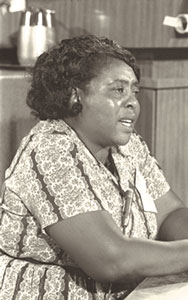Survivors of racist sterilization dissed by North Carolina Senate
Published Jul 6, 2012 6:41 PM
By Eva Panjwani
Carrboro, N.C.
State legislators in North Carolina in June passed over a proposal that sought to compensate the living survivors of the state’s long-lasting forced sterilization and eugenics program, citing budgetary concerns.
|
Fannie Lou Hamer, who herself was unknowingly
sterilized, became a great Civil Rights
leader. Pictured here, she is challenging the
all-white Mississippi dele gation to the 1964
Democratic Convention.
|
The program was shaped by a eugenics law that the state passed in 1929 that allowed sterilization for three reasons: epilepsy, sickness and “feeblemindedness.” In practice, the state eugenics board freely passed judgment on working-class people, mainly poor Black women. In a state where white men had once owned Black women’s bodies, white men were now condemning them to sterility, charging them with suspected promiscuity and premarital sex. Gays and lesbians were also targeted for sterilization.
Recent records indicate that more than 7,600 people were sterilized between 1929 and 1974 in one of the country’s most aggressive and largest eugenics programs. By the 1960s, 99 percent of those sterilized in North Carolina were female, and more than 60 percent were Black.
The eugenics movement in the U.S. was fueled by faulty bourgeois research claiming that human behavior was influenced solely by genes. More than 30 states had eugenic sterilization programs. People who were involuntarily sterilized had little or no idea what was happening to them. These programs were bankrolled by the rich, partly motivated by concerns of how much the mentally ill and “welfare mothers” were costing taxpayers and the state.
“Six out of every 10 Negro women were taken to the Sunflower City Hospital [in Mississippi] to be sterilized for no reason at all,” said Mississippi’s Fannie Lou Hamer in a 1965 speech at the Capitol in Washington. Hamer herself had been sterilized four years earlier without her knowledge or consent.
A prominent civil rights activist, Hamer was one of the first Black women to publicly acknowledge the then-hidden abuse: forcible sterilization of people of color. “Often the women were not told that they had been sterilized until they were released from the hospital,” she said.
Most states abandoned their efforts at sterilization after World War II, when the practice became associated with Nazi Germany’s genocidal programs for “racial purity.” North Carolina stood out because it actively increased funding and resources for its program after the war and went on operating quietly, with decades of little to no public debate.
In some North Carolina counties where racism was especially rampant, doctors would perform operations without prior approval and the eugenics board would backdate permission to cover up the illegal procedures. An estimated 2,000 women 18 years old and younger were targeted; the consent process and parental approval were questionably applied.
Democratic governor, Bev Perdue, had proposed to set aside up to $10 million in the upcoming budget in order to give $50,000 to each remaining survivor. With the backing of Republican speaker, Thom Tillis, the proposal did pass the House. Shortly afterward, however, it was rejected by the State Senate. Legislators expressed concern that passing the proposal would open the door for reparations for the descendants of those who had been enslaved until 1865.
The sterilization program finally ended in 1974, but it left a legacy that is still alive in North Carolina. The survivors are living reminders of an era that openly trampled on the human rights of the poor and the powerless.
Articles copyright 1995-2012 Workers World.
Verbatim copying and distribution of this entire article is permitted in any medium without royalty provided this notice is preserved.
Workers World, 55 W. 17 St., NY, NY 10011
Email:
[email protected]
Subscribe
[email protected]
Support independent news
DONATE


